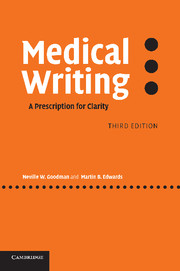Book contents
- Frontmatter
- Contents
- Preface to the first edition
- Preface to the third edition
- Acknowledgements
- PART I PROBLEM: THE ILLNESS
- PART II SOLUTION: SYMPTOMATIC RELIEF
- 3 Guidelines to clearer writing
- 4 Is there a better word?
- 5 Superfluous words
- 6 Imprecise words and phrases
- 7 Superfluous phrases
- 8 Trouble with short words
- 9 Use of the passive voice
- 10 Consistency: number and tenses
- 11 Circumlocution, metaphor and cliché
- 12 Word order and pronouns
- 13 Punctuation
- 14 Constructing sentences
- 15 Drawing clear graphs
- PART III PRACTICE: RECUPERATION
- Appendix: examples to rewrite
- References and further reading
- Index
12 - Word order and pronouns
Published online by Cambridge University Press: 23 November 2009
- Frontmatter
- Contents
- Preface to the first edition
- Preface to the third edition
- Acknowledgements
- PART I PROBLEM: THE ILLNESS
- PART II SOLUTION: SYMPTOMATIC RELIEF
- 3 Guidelines to clearer writing
- 4 Is there a better word?
- 5 Superfluous words
- 6 Imprecise words and phrases
- 7 Superfluous phrases
- 8 Trouble with short words
- 9 Use of the passive voice
- 10 Consistency: number and tenses
- 11 Circumlocution, metaphor and cliché
- 12 Word order and pronouns
- 13 Punctuation
- 14 Constructing sentences
- 15 Drawing clear graphs
- PART III PRACTICE: RECUPERATION
- Appendix: examples to rewrite
- References and further reading
- Index
Summary
Nouns, adjectives and prepositions do not change their endings in English to indicate how they relate to each other. Words can be stressed in speech, but although underlining and italics will indicate stress in writing they are devices to use sparingly. Some journals will not accept italicized emphases. In written English, meaning is determined first by the positions, or presumed positions, of words, phrases and clauses, and second by the punctuation between them.
Consider this simple example.
The policy was changed after a near clinical disaster.
Readers expect near to qualify the word next to it, clinical. Although it takes only a moment to realize that the sense is of a clinical near-disaster and not of a disaster that was nearly clinical, the expression is a jolt to the flow of understanding. The example is better as The policy was changed after there was nearly a clinical disaster.
Sometimes the interpreted meaning may be far from the intended one, as in this letter from a firm of solicitors to a general practice:
We feel it can only improve our service to clients, particularly as [many] of our personal injury/domestic violence clients seek our assistance after visiting your health centre.
Note the ‘lazy slash’, which is better replaced with and: see p. 178.
Missing words
Words are often left out but their position is assumed and understood by readers as if they were there:
The dose of morphine is 10 mg, and of heroin is 5 mg.
- Type
- Chapter
- Information
- Medical WritingA Prescription for Clarity, pp. 161 - 172Publisher: Cambridge University PressPrint publication year: 2006



